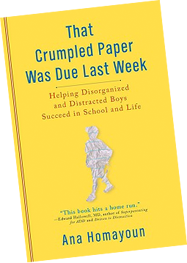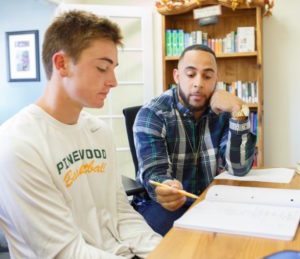I often get questions in my inbox, and while I am (sadly!) not able to answer them all, I am happy to answer a question from the mailbag and share my response in hopes it helps others. Enjoy!
 Hi Ana!
Hi Ana!
That Crumpled Paper has been such a positive influence on my son and in our family! I’m so grateful. In the small town that we live in, only the kids with IEPs are required to carry and use a planner, starting in junior high. I couldn’t figure out why my son and the high school boys refused to use them. It’s because of the stigma! My son was getting a zero once a week in 8th grade and I insisted that he start using a planner. He got tears in his eyes saying he would lose all his friends because they would think he is [in] “Special Ed.” I spoke to the principal about it and he acknowledged the stigma, but has no plans to change anything, which is very frustrating. Are you aware of any research on the effectiveness of planners that I could share? With him, with the school board, with other moms? It seems crazy. My son did acknowledge that some super brainy girls carry them too! I appreciate any suggestions.
Dear “Paper Planners for Everyone,”
Thank you for your note – and I am so glad to hear that you found my first book, That Crumpled Paper Was Due Last Week, so helpful. It is truly rewarding to hear that eight years after the book came out, families are still finding it to be a useful resource.
There are actually two parts to your question that I think are important to answer. The first is related to the shame and stigma associated with qualifying for special services or special education. In fact, it is that shame and stigma that prevents many kids from utilizing the services they need in order to reach their full academic and personal potential. So this situation presents you with a teachable moment.
Your son’s reaction is certainly not unique, especially in an age where we place so much (and perhaps too much) emphasis on academic excellence through numerical markers of success and not enough emphasis on the importance of social and emotional learning and caring about others. We all – parents, educators, and students – play a role in reducing stigma and shame  around needing social, emotional, and academic support. There’s nothing wrong with a student having learning differences or needing additional time to process or comprehend information, and I hope we can all work together to start a conversation on compassion, empathy, inclusion, and understanding. The next time your son says he is concerned that others would think he is in special education, you might respond by asking him why that would matter, perhaps initiating a greater conversation on inclusive kindness toward others with differences.
around needing social, emotional, and academic support. There’s nothing wrong with a student having learning differences or needing additional time to process or comprehend information, and I hope we can all work together to start a conversation on compassion, empathy, inclusion, and understanding. The next time your son says he is concerned that others would think he is in special education, you might respond by asking him why that would matter, perhaps initiating a greater conversation on inclusive kindness toward others with differences.
In terms of paper planners, there is evidence to suggest that writing down information by hand can help improve retention. Evidence from a recent study and others suggests that writing by hand engages the mind and can help children pay attention. One of the reasons highlighted in this article from Scientific American is that reading on paper allows us to create mental maps that anchor meaning to structure, and this anchoring helps us retain the information better.
In my office, I frequently see how effective it is to provide a structure of time and space for students to write all their assignments, activities, and appointments in a written planner. For many students, the act of writing down everything in one place is stress-relieving, as it allows them to take things out of top of mind and put them on paper. It also helps students begin to problem solve around managing their time – for instance, if a student has two exams on Thursday morning and knows she has a track meet that will go until late on Wednesday night, she might begin preparing in advance to help her budget her time and energy.
 In schools, I’ve also seen the benefits for teachers who encourage, require, or offer incentives for paper planner use. By giving students five minutes to write down all their assignments everyday, or twenty minutes every week to “regroup” and sort through their loose papers, teachers are more likely to get assignments turned in on time and are less likely to have to track down missing or forgotten work. A little structured time goes a long way, particularly for middle school and high school students.
In schools, I’ve also seen the benefits for teachers who encourage, require, or offer incentives for paper planner use. By giving students five minutes to write down all their assignments everyday, or twenty minutes every week to “regroup” and sort through their loose papers, teachers are more likely to get assignments turned in on time and are less likely to have to track down missing or forgotten work. A little structured time goes a long way, particularly for middle school and high school students.
A parent recently shared that her kids’ elementary school requires students to use a paper planner starting in third grade (the school asks for some cash as part of school supplies to cover the cost and then distributes the planners to all students). They’re strongly recommended at the middle level, too, and the school sells them at registration (the planners are printed with the school logo and some school-specific information).
I’ve found that the best planners are those that are simple and offer opportunities to manage and track appointments, assignments, and activities, schedule time, and set goals.
I hope this helps!
Ana

